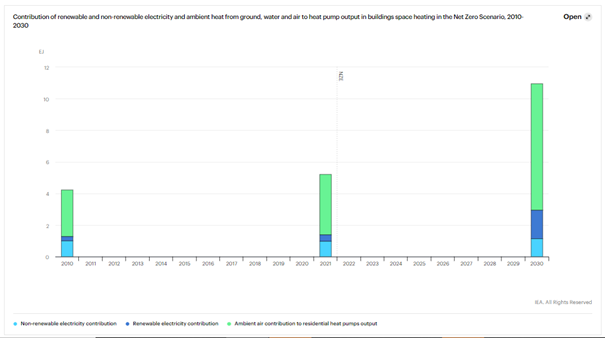Recent policy action and technology developments – record renewable electricity capacity additions, as an example – indicate that momentum is accelerating on clean energy transitions. Yet, of the 55 components tracked, only two, electric vehicles and lighting are fully “On track” (green) with the Net Zero by 2050 Scenario trajectory. This demonstrates a need for greater and sustained efforts across a range of technologies and sectors to ensure the world can meet its energy and climate goals.
In 2021 heat pump sales increased by more than 13% globally. In the European Union, of which the largest markets are France, Italy, and Germany, sales grew by around 35% year-on-year, exceeding 2.2 million units. The next most dynamic markets were the United States (up 15%), Japan (up 13%), and China (up 13% for air-source heat pumps). Yet, heat pumps are still categorized as “More efforts needed” (orange) since heat pumps represented less than 10% of global heating equipment sales in 2021, while fossil fuel equipment still accounted for 45%. In the Net Zero Scenario, heat pumps shall represent more than half of total heating sales by 2030. By that year heat pumps should cover at least 20% of the heating needs in buildings to follow the IEA’s trajectory towards Net Zero by 2050. While global energy data on heat pumps are limited, IEA estimate that in 2021 heat pumps met only around 10% of the global heating need in buildings – less than half of what’s needed in the NZE by 2030.

The report states that innovation is needed to deploy highly efficient heat pumps in all market segments and that heat distribution systems need to be taken into account, as well as active controls and storage solutions. This area was explored in the recently finalized HPT Annex 55 /ES Task 34, which was performed in collaboration with the Mission Innovation initiative.
Policy support for heat pumps is increasing rapidly to meet decarbonization ambitions. In addition, several policies are developed to support the heat pump market prompted by record-high energy prices and the anticipation of upcoming winter challenges, especially in Europe, following the Russian invasion of Ukraine.
The part of the TCEP report dealing with Heat Pumps can be found here. HPT TCP has contributed with input and review to this report.
The full analysis is available on the online portal.
The IEA’s expanded clean energy innovation tracker was also launched on the same day, which includes an update of the Clean Technology Guide, as well as a new publicly available global database of clean energy demonstration projects.


